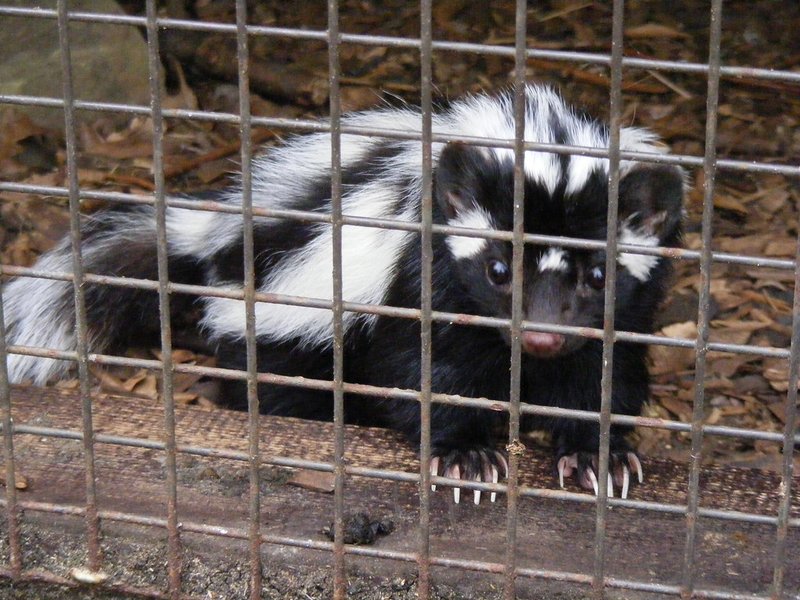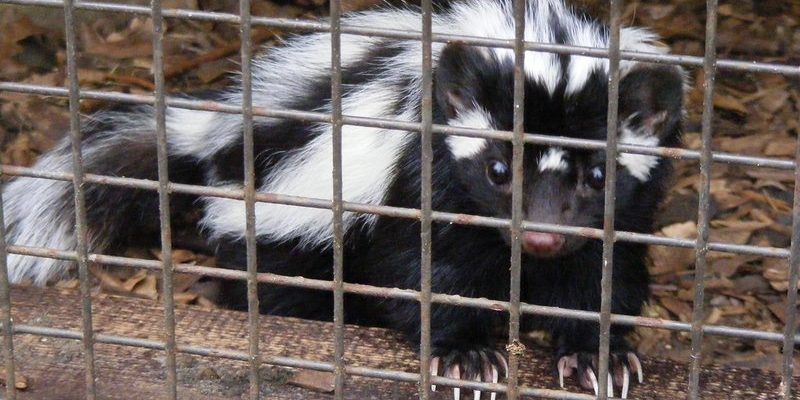
The zorilla, known scientifically as Ictonyx striatus, is a small carnivorous mammal that belongs to the weasel family. Often mistaken for a skunk due to its striking black and white stripes, the zorilla stands out with its sleek body and long, bushy tail. You can find these creatures primarily in the grassy plains and savanna regions of sub-Saharan Africa, where they roam both day and night in search of food. Unlike many other species in the weasel family, zorillas are known for their unique behavior and distinctive characteristics.
Imagine a tiny animal that embodies both a playful spirit and fierce independence—this is the zorilla. As if nature decided to combine the best traits of weasels and skunks, the zorilla is not only cute but also equipped with some impressive survival skills. They may look adorable, but they are far from defenseless, employing a potent mixture of cunning and a foul-smelling spray when threatened. This unique blend of charm and danger makes them one of the most intriguing animals in their habitat.
Physical Characteristics
When you first set your eyes on a zorilla, you’ll likely be struck by its beautiful striped coat. The body is primarily covered in black fur with bold white stripes running down its back, giving it a distinct appearance. On average, zorillas weigh between 3 to 6 pounds and measure about 18 to 24 inches long, with their tails adding an additional 12 inches. This combination of size and agility helps them navigate their environment with grace.
One of the most fascinating aspects of the zorilla’s anatomy is its strong scent glands located near the base of the tail. These glands release a pungent odor, similar to that of a skunk, which serves as a defense mechanism against predators. So, if you ever find yourself eye-to-eye with a zorilla, prepare for a less-than-pleasant experience if it feels cornered! It’s a true testament to how evolution has equipped this creature with the tools it needs to survive in the wild.
Habitat and Distribution
Zorillas are primarily found across various parts of Africa, particularly in regions with open grasslands and bushy areas. Their preference for savannas, grasslands, and even some wooded regions allows them to thrive. They are adaptable animals, capable of living in a range of environments—from the dry grasslands of the Serengeti to the wetter regions of central Africa. However, they tend to avoid dense forests and urban areas.
When it comes to their dens, zorillas are resourceful. They often take refuge in burrows or abandoned nests left behind by other animals. This not only provides them with shelter but also helps them stay out of sight from potential predators. They are primarily nocturnal, which means they are most active during the night. This nocturnal lifestyle allows zorillas to minimize their chances of encounters with larger predators, making their survival in the wild more secure.
| Characteristic | Details |
| Size | 18-24 inches (body); 12 inches (tail) |
| Weight | 3-6 pounds |
| Habitat | Savannas, grasslands, and bushy areas |
| Diet | Insects, small mammals, and birds |
| Lifespan | 5-10 years in the wild |
Diet and Hunting Behavior
The zorilla is a carnivore, which means it primarily feeds on meat. Its diet mainly consists of insects, small mammals, birds, and even the occasional frog. What’s particularly interesting about zorillas is how they hunt—they are known for their clever and stealthy approach. They quietly stalk their prey, using their sharp senses to detect movement and sounds. Once they spot their target, they pounce with remarkable agility.
What sets them apart from other predators is their method of hunting. Zorillas often dig into the ground to uncover larvae and other insects, using their strong claws to break through soil and leaf litter. This behavior not only showcases their resourcefulness but also highlights their role in controlling insect populations in their ecosystem. So, if you ever wondered who’s keeping those pesky bugs in check, the zorilla is part of that solution!
Behavior and Social Structure
Zorillas are solitary animals, generally preferring to roam alone. However, during the mating season, they may come together to find a partner. Male zorillas are known for their elaborate courtship behaviors, which often include vocalizations and displays of agility to attract females. Once they mate, the female typically raises the young on her own, which adds to their solitary nature. The young, usually born in litters of two to four, rely on their mother for survival in the early stages of life.
You might be surprised to learn that zorillas are quite vocal creatures! They communicate with each other through a series of grunts, growls, and hisses. This vocalization plays a key role in establishing territory and signaling to others when it’s time to back off. Such clever communication helps them maintain their space in the wild, reducing the chances of confrontations with other zorillas and potential predators.
Conservation Status
Currently, the zorilla is classified as a species of “Least Concern” by the International Union for Conservation of Nature (IUCN). This means that, at this moment, they are not facing immediate threats of extinction. However, like many wild animals, they do face challenges related to habitat loss and hunting. As human activities continue to encroach on their natural habitats, it’s crucial to keep an eye on their populations and take action to protect their environments.
Conservation efforts are important not only for the zorilla but also for the ecosystems they inhabit. By protecting these animals, we help maintain the delicate balance of wildlife that contributes to the health of our planet. Education and awareness about their role in the ecosystem can go a long way in ensuring their continued existence in the wild.
Interesting Facts About Zorillas
Did you know that zorillas have some peculiar traits that make them truly fascinating? For instance, their distinctive appearance led early explorers to mistake them for skunks! In fact, the name “zorilla” comes from the Spanish word “zorrillo,” which means “little fox.” This highlights how cultural interpretations can shape our understanding of wildlife. In addition, their ability to spray a foul-smelling substance when threatened showcases nature’s incredible creativity in defense mechanisms.
Moreover, zorillas have a unique behavior called “rolling,” where they may roll around in the dirt or grass. This action might seem playful, but it likely serves a purpose—like camouflaging themselves or applying scents onto their fur to mark their territory. Nature has truly equipped the zorilla with fascinating adaptations to thrive in its environment.
FAQ
What do zorillas eat?
Zorillas primarily eat insects, small mammals, and birds. They are carnivorous and rely on their excellent hunting skills to find food, often digging into the ground for larvae. Their diet helps control insect populations in their environment, making them a crucial part of the ecosystem.
Where can I find zorillas?
You can find zorillas in various parts of sub-Saharan Africa, particularly in open grasslands and savannas. They thrive in environments where they can hunt and dig for food, avoiding dense forests and urban areas. Their adaptability to different habitats helps them survive in a wide range of conditions.
How do zorillas defend themselves?
Zorillas have a defense mechanism that resembles that of skunks. They can spray a foul-smelling liquid from scent glands near their tail, deterring potential predators. This unique adaptation allows them to escape and survive in the wild even when faced with larger threats.
Are zorillas social animals?
Zorillas are primarily solitary creatures, but they may come together during mating season. They communicate through vocalizations and body language to establish territory and signal to others. Their independent nature means they often prefer to hunt and roam alone.
How long do zorillas live?
In the wild, zorillas typically have a lifespan of 5 to 10 years. Factors like predation, food availability, and environmental conditions can all impact their life expectancy. Proper conservation efforts are essential to ensuring their survival and well-being in their natural habitats.
Can zorillas be kept as pets?
While zorillas may seem cute and appealing, they are wild animals and not recommended as pets. They require a specific environment, diet, and social structure that are difficult to replicate in captivity. Additionally, their strong scent and behavior make them unsuitable companions for most households.
Do zorillas have any predators?
Yes, zorillas have several natural predators, including larger carnivores like lions, hyenas, and even birds of prey. However, their ability to spray a strong-smelling liquid often helps them escape attacks from these threats, showcasing their unique approach to survival.
What is the conservation status of zorillas?
Zorillas are currently classified as “Least Concern” by the IUCN. While they are not facing immediate threats of extinction, they do face challenges related to habitat loss and hunting. Conservation efforts are important to ensure their continued existence and the health of their ecosystems.
What is the role of zorillas in their ecosystem?
Zorillas play an important role in their ecosystems by controlling insect populations and contributing to the balance of the food web. As predators, they help maintain the health of their environment, showcasing how every species, no matter how small, has a part to play in nature.
How do zorillas communicate?
Zorillas communicate through a variety of vocalizations such as grunts and hisses, as well as body language. These sounds help establish territory and signal to other zorillas when to back off. Their vocal communication is key to their survival in the wild.
Are zorillas endangered?
While zorillas are currently not considered endangered, habitat loss and hunting can pose threats to their populations. It is essential to continue monitoring their status and implementing conservation measures to protect their habitats and ensure their survival in the wild.

